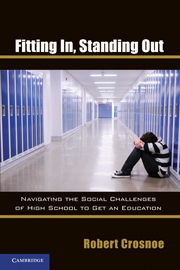Book contents
- Frontmatter
- Contents
- Acknowledgments
- PART I HIGH SCHOOLS AS CONTEXTS OF DEVELOPMENT
- PART II A CASE STUDY OF SOCIAL AND ACADEMIC EXPERIENCES IN HIGH SCHOOL
- 5 The Stakes of Social Marginalization
- 6 Teenagers at Particular Risk
- 7 How Teenagers Know What They Know and Why It Matters
- 8 Sources of Resilience
- PART III HELPING TEENAGERS NAVIGATE HIGH SCHOOL
- Works Cited
- Index
7 - How Teenagers Know What They Know and Why It Matters
Published online by Cambridge University Press: 05 June 2012
- Frontmatter
- Contents
- Acknowledgments
- PART I HIGH SCHOOLS AS CONTEXTS OF DEVELOPMENT
- PART II A CASE STUDY OF SOCIAL AND ACADEMIC EXPERIENCES IN HIGH SCHOOL
- 5 The Stakes of Social Marginalization
- 6 Teenagers at Particular Risk
- 7 How Teenagers Know What They Know and Why It Matters
- 8 Sources of Resilience
- PART III HELPING TEENAGERS NAVIGATE HIGH SCHOOL
- Works Cited
- Index
Summary
The educational risks of not fitting in socially at high school are by no means universal. After all, feelings of not fitting in did not perfectly predict college going (or socioemotional functioning or academic progress either) in Add Health, and being obese and/or gay/lesbian did not perfectly predict feelings of not fitting in. The not-fitting-in pathway that I have put forward and tested, therefore, is a probabilistic one. Feeling like one does not fit in at school raises the probability of various psychological and behavioral mechanisms that lower the probability of going to college, but there is nothing guaranteed or absolute about this pathway. That variability in how this pathway plays out among American teenagers – variability in the potential risks of not fitting in and in the actual experience of not fitting in – is important. Figuring out who feels like they do not fit in (and who does) and who reacts to such feelings in problematic ways (and who does not) tells us which teenagers need help the most and points to different strategies for helping them.
To gain such an understanding, focusing more narrowly on the central piece of the not-fitting-in pathway – in other words, focusing on feelings of not fitting in themselves – is necessary. After all, if teenagers who may be vulnerable to feeling as though they do not fit in never develop those feelings or if teenagers who feel like they do not fit in manage to cope with those feelings in healthy ways, then the full pathway breaks down.
- Type
- Chapter
- Information
- Fitting In, Standing OutNavigating the Social Challenges of High School to Get an Education, pp. 130 - 173Publisher: Cambridge University PressPrint publication year: 2011



